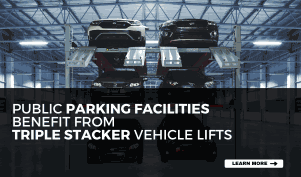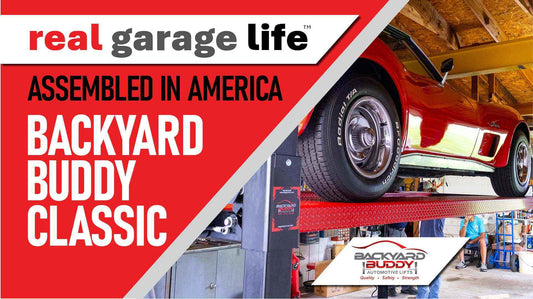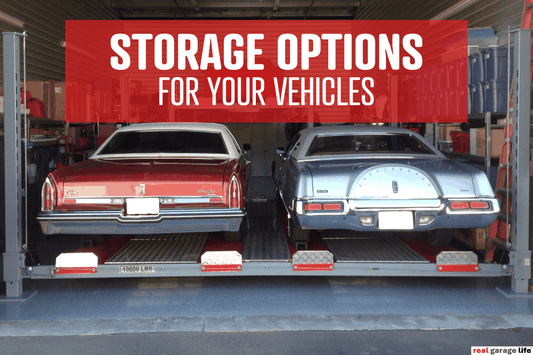4-Post Lift Tips & Tricks
Share
Lubrication
The 4-post lift, just by design, is going to have less maintenance. Number one, because of the runways, you don't have any pivot points for arms that you need to lubricate. What you do have is four columns that run on a collar with sliders in all four corners, and that's a friction point.
What we like to do is wax the posts with good old-fashioned paste wax. Wipe it on, rub it on, and wipe it off. That helps lubricate the sliders, and that'll keep it from chattering. We don't get a lot of chattering, but if you do, the first thing to do is put some paste wax on your posts again. How often? That's going to be up to you. It depends on how much you use it, because a lot of times this lift will go in a garage with a car on top of it that may sit for 3-4 months before it ever gets used again. You just kind of have to judge that for yourself.
This lift does have lube points because of the sheaves underneath where the cables run. The cables on this lift are picking up the vehicle, unlike equalizer cables on our two-post lifts. They're the lifting points – there's one in all four corners. You'll notice four cables coming from your hydraulic cylinder. When the cylinder pulls in, it's pulling on those cables.
Speaking of the sheaves underneath that the cables wrap around, there's a pin that goes through the center that spins. Our Backyard Buddy lifts have ports for grease fittings. Because the grease fitting sticks down, we don't leave them in it. What you would have gotten with this lift is a spare grease fitting to screw in there to grease your pin. Take it out, screw it in the next one, grease your pin, take it out.
If you notice slack in the cable now because it's sitting on the locks, that's when I like to grease them. It allows the grease to get where it needs to go. Our pins are ported, so when you're greasing it, it's not going everywhere. There's a hole drilled sideways into our port, and it's greasing the collar of the bearing or the sheave. It's going to take a lot of grease – you'll feel it as you're pumping it. You'll feel it easy at first, and then it'll start to get tight. That's when you know you're putting the grease where it needs to be. Do them once a year.
We also have sheaves which direct the cables to the top of the column. All four corners will have a sheave behind the cover. It's the same sheave as we have down below and has a pin going through it, but you'll notice this has the grease fitting in it. The reason we leave the grease fittings in there is because it's not underneath where you're going to hit your head on it. For all these, you don't have to take the grease fitting in and out – just put your gun on there, pump it twice, once a year, and you've greased that sheave. It's very important with a 4-post lift to keep those pins and sheaves lubricated because there's a lot of pressure holding whatever vehicle you have on there.
Cables and Locks
Now, about the cables – I'm going to lower this lift a little bit. Like I said, these cables are supporting each corner. By nature, these are spun cables, so they will tend to stretch, which is very normal, especially an initial stretch. Down the road, once most of the initial stretch is out, you may not need to adjust them as much. Again, it depends on how much you use your lift.
The simple way to adjust it is at the top. Each one of those studs that the cables connect to has adjustment on it. What I like to do to check the adjustment is get it to a nice workable height and take a tape measurement. Measure from the base to the bottom of the collar on all four sides, and whichever one's the highest, you just adjust the other ones until they're all the same.
For example, say this is 3 feet and that's 2 feet 11½ – you'd adjust that up so it comes up to where you put your tape measure to both 3 feet. Then do the same to the front. You're going to find that adjustment-wise, the front is going to take more adjustment. That's just because the front (meaning the power unit column) has the longest cables. The front cables come all the way down and spin all the way back up before they go over and up. That right front cable is probably three times as long as the rear cable, so of course, when you get a little bit of stretch, you're going to get more stretch with it.
Lastly, you see a spring here that engages your locks every time you hit a window. There'll be one on the front and one in the back. All your locks on all your lifts are going to be engaged by springs. Springs break, so just take a visual look to see if that spring is still on there. They last a long time, but they do break. The best thing to do is just take a visual check to make sure your springs are on because that engages your locks.
Always set your lifts on the locks, whether it's a 2-post or 4-post. When it's not on the locks, like right now, if something catastrophic were to happen – like a cable blowing out or a hose breaking – it's going to drop. There's going to be a catastrophic event. It will catch itself with secondary locks to keep from anything catastrophic but say you're underneath there when it happens and your head's only a couple inches away from where you're working – it could hit you in the head. Always set your lifts on the locks.











